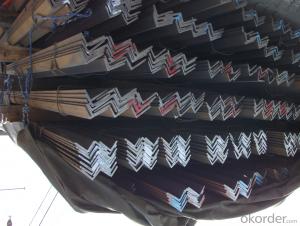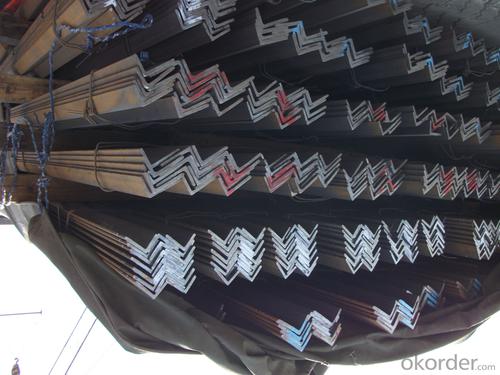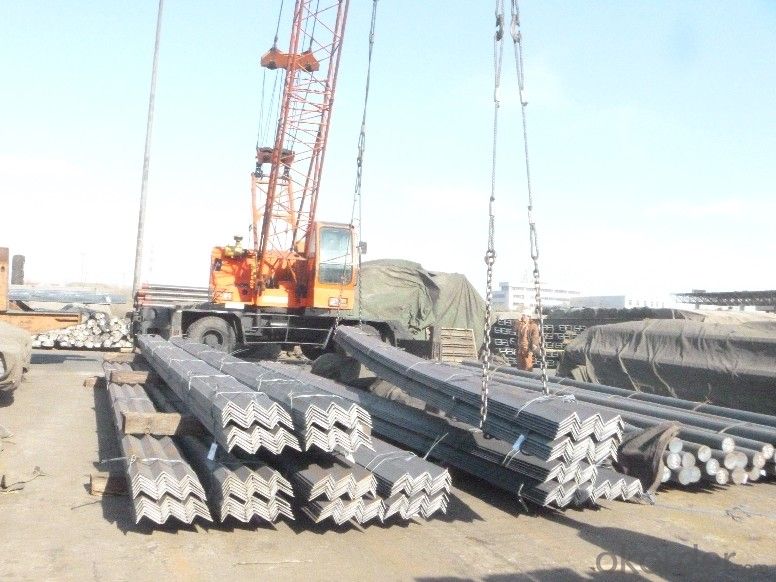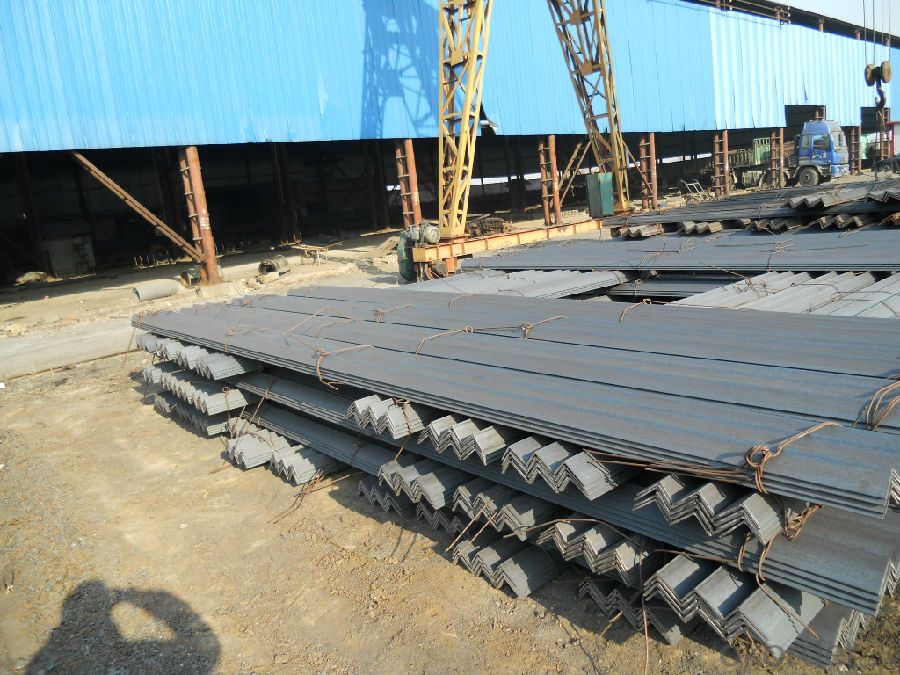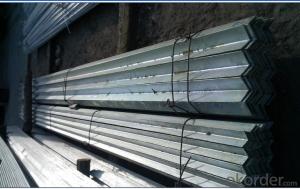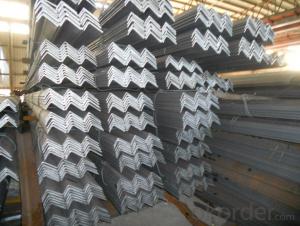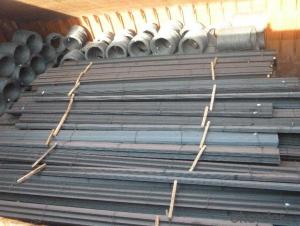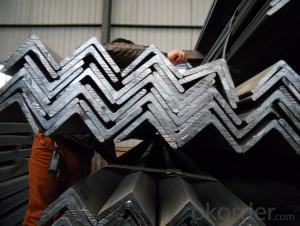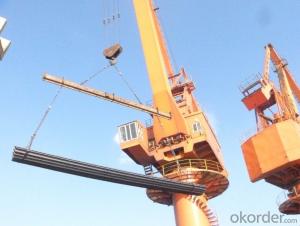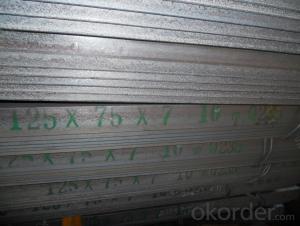Hot Rolled Steel Unequal Angle Bar Many Sizes
- Loading Port:
- China Main Port
- Payment Terms:
- TT or LC
- Min Order Qty:
- -
- Supply Capability:
- -
OKorder Service Pledge
OKorder Financial Service
You Might Also Like
Product Description:
OKorder is offering Angle Bar at great prices with worldwide shipping. Our supplier is a world-class manufacturer of steel, with our products utilized the world over. OKorder annually supplies products to European, North American and Asian markets. We provide quotations within 24 hours of receiving an inquiry and guarantee competitive prices.
Product Applications:
According to the needs of different structures, Angle can compose to different force support component, and also can be the connections between components. It is widely used in various building structures and engineering structures such as roof beams, bridges, transmission towers, hoisting machinery and transport machinery, ships, industrial furnaces, reaction tower, container frame and warehouse etc.
.
Product Advantages:
OKorder's Angle Bar are durable, strong, and resist corrosion.
Main Product Features:
· Premium quality
· Prompt delivery & seaworthy packing (30 days after receiving deposit)
· Corrosion resistance
· Can be recycled and reused
· Mill test certification
· Professional Service
· Competitive pricing
Product Specifications:
1. Invoicing on theoretical weight or actual weight as customer request
2. Length: 6m, 9m, 12m as following table
3. Sizes
Name | Stainless Steel Angles | ||||||
Standard | ASTM A554, A312, A249, A269 and A270 | ||||||
Material Grade | 304,316,201,202, 316L,430 | ||||||
Length | 6m or as customers' request | ||||||
Tolerance | a) thickness: +/-0. 15mm | ||||||
b) Length:+/-4. 5mm - 0mm | |||||||
Surface | 180G, 320G, 400G Satin / Hairline(Matt Finish, Brush, Dull Finish) 400G, 500G, 600G or 800G Mirror finish | ||||||
Application | Decoration construction, upholstery, industry instruments | ||||||
Test | Squash test, Extended test, Water pressure test, Crystal rot test, Heat treatment, NDT | ||||||
Chemical Composition of Material | Composition Material | 201 | 202 | 304 | 316L | 430 | |
C | ≤0.15 | ≤0.15 | ≤0.08 | ≤0.08 | ≤0.12 | ||
Si | ≤1.00 | ≤1.00 | ≤1.00 | ≤1.00 | ≤1.00 | ||
Mn | 5.5-7.5 | 7.5-10 | ≤2.00 | ≤2.00 | ≤1.00 | ||
P | ≤0.06 | ≤0.06 | ≤0.045 | ≤0.045 | ≤0.040 | ||
S | ≤0.03 | ≤0.03 | ≤0.030 | ≤0.030 | ≤0.030 | ||
Cr | 16-18 | 17-19 | 18-20 | 16-18 | 16-18 | ||
Ni | 3.5-5.5 | 4-6 | 8-10.5 | 10-14 | |||
Mo | 2.0-3.0 | ||||||
Mechanical Property | Material Item | 201 | 202 | 304 | 316L | ||
Tensile Strength | ≥535 | ≥520 | ≥520 | ≥520 | |||
Yield Strength | ≥245 | ≥205 | ≥205 | ≥205 | |||
Extension | ≥30% | ≥30% | ≥35% | ≥35% | |||
Hardness (HV) | <253 | <253 | <200 | <200 | |||
FAQ:
Q1: Why buy Materials & Equipment from OKorder.com?
A1: All products offered byOKorder.com are carefully selected from China's most reliable manufacturing enterprises. Through its ISO certifications, OKorder.com adheres to the highest standards and a commitment to supply chain safety and customer satisfaction.
Q2: How do we guarantee the quality of our products?
A2: We have established an advanced quality management system which conducts strict quality tests at every step, from raw materials to the final product. At the same time, we provide extensive follow-up service assurances as required.
Q3: How soon can we receive the product after purchase?
A3: Within three days of placing an order, we will begin production. The specific shipping date is dependent upon international and government factors, but is typically 7 to 10 workdays.
Images:
- Q: How do you determine the required angle size for a specific application?
- To determine the required angle size for a specific application, several factors need to be considered. Firstly, it is crucial to understand the purpose or function of the application. Different applications may require different angles depending on the desired outcome. For example, if the application involves cutting or shaping materials, the angle size may need to be determined based on the desired precision or level of detail required. Secondly, it is important to consider the materials involved in the application. Some materials may be more brittle or prone to damage, while others may be more flexible. The angle size needs to be chosen in such a way that it accounts for the material's properties and minimizes the risk of damage or failure. Thirdly, the specific conditions or environment in which the application will be used must be taken into account. Factors such as temperature, pressure, or moisture levels can affect the performance of the application and may influence the required angle size. It is essential to choose an angle size that can withstand the expected conditions and provide optimal functionality. Additionally, it is beneficial to consult industry standards or guidelines that may exist for the specific application. These standards often provide recommended angle sizes based on best practices and past experiences. They can serve as a useful reference point to determine the required angle size. Lastly, it may be necessary to conduct testing or simulations to verify the chosen angle size. By creating prototypes or using computer-aided design (CAD) software, one can evaluate the performance and effectiveness of different angle sizes before finalizing the decision. In conclusion, determining the required angle size for a specific application involves considering the purpose, materials, environmental conditions, industry standards, and potentially conducting testing or simulations. By analyzing these factors, one can make an informed decision and choose the most suitable angle size for the application.
- Q: Are there any special considerations when handling or installing steel angles?
- Yes, there are several special considerations that should be taken into account when handling or installing steel angles. Firstly, it is important to ensure that the angles are stored and transported properly to prevent any damage. Steel angles should be stored in a dry and well-ventilated area to prevent rusting. When transporting, they should be secured properly to prevent any accidents or injuries. Secondly, steel angles should be installed on a solid and level surface to ensure stability and proper load distribution. It is recommended to use a level and plumb line to ensure accurate installation. Thirdly, it is crucial to use the appropriate size and type of fasteners when installing steel angles. The fasteners should be compatible with the angle and the material it is being attached to. It is also important to ensure that the fasteners are tightened properly to avoid any loosening or failure. Additionally, it is important to consider the load-bearing capacity of the steel angles. The angles should be selected based on the expected load and application requirements. It is advisable to consult with a structural engineer or a professional to determine the appropriate size and type of steel angles for the specific project. Lastly, safety precautions should be followed when handling and installing steel angles. Protective gear, such as gloves and safety glasses, should be worn to prevent any injuries. It is also important to follow safe lifting practices and use proper lifting equipment when handling heavy steel angles. Overall, it is important to take these special considerations into account when handling or installing steel angles to ensure proper installation, structural integrity, and safety.
- Q: What is the difference between mill finish and hot-dip galvanized steel angles?
- Mill finish steel angles refer to angles that have undergone minimal processing after being formed, typically leaving a rough, dull surface. On the other hand, hot-dip galvanized steel angles have been coated with a layer of zinc through a process called hot-dip galvanization. This coating provides enhanced corrosion resistance, making galvanized angles suitable for outdoor and high-moisture environments.
- Q: What is the maximum length of a steel angle that can be transported?
- The maximum length of a steel angle that can be transported depends on various factors, including transportation regulations and limitations, the size and capacity of the transport vehicle, and any logistical constraints. In general, standard transport vehicles like trucks or trailers can typically accommodate steel angles up to a certain length, often around 40 feet (12.2 meters). These vehicles may have limitations on the length of cargo they can carry due to road transportation regulations or physical constraints. However, it's important to note that specialized transport options, such as flatbed trucks or lowboy trailers, may be available to accommodate longer steel angles. These specialized vehicles are designed to carry oversized or heavy loads and may have extended cargo beds or adjustable trailers to accommodate longer lengths. Ultimately, the maximum length of a steel angle that can be transported will vary depending on the specific circumstances and available transport options. It is recommended to consult with transportation professionals or logistics experts to determine the best and most suitable means of transporting steel angles of varying lengths.
- Q: What is the difference between equal and unequal steel angles?
- Equal steel angles have equal sides and angles, meaning they form right angles. Unequal steel angles, on the other hand, have different sides and angles, resulting in non-right angles.
- Q: How are steel angles installed?
- Steel angles are typically installed using a few simple steps. First, you will need to mark the desired location for the angle on the surface or structure where it will be installed. Next, using a level and measuring tape, ensure that the angle is aligned correctly and mark the positions for the screw or bolt holes. Once the markings are made, you will need to pre-drill the holes using a drill bit that is slightly smaller than the diameter of the screws or bolts you will be using. This will prevent the steel angle from cracking or splitting during installation. After pre-drilling the holes, place the steel angle back in position and align the holes with the markings on the surface. Use a wrench or screwdriver to tighten the screws or bolts securely, making sure the angle is firmly attached. It is important to follow the manufacturer's instructions and recommendations for the specific type and size of steel angle being installed. Additionally, ensure that the surface or structure where the angle is being installed is able to support the weight and load that will be applied to it. Overall, steel angles are relatively simple to install and provide excellent structural support in various applications such as construction, manufacturing, and DIY projects.
- Q: Can steel angles be drilled or cut?
- Yes, steel angles can be drilled or cut. Steel angles are a versatile structural material that is commonly used in various construction and manufacturing projects. They can be easily drilled to create holes for bolts, screws, or other fasteners. Additionally, steel angles can be cut to specific lengths or shapes using tools such as saws, plasma cutters, or shears. The ability to drill or cut steel angles makes them highly adaptable and suitable for a wide range of applications.
- Q: What is the difference between hot-rolled and cold-rolled steel angles?
- Hot-rolled and cold-rolled steel angles refer to two different manufacturing processes used to create steel angles with varying characteristics. Hot-rolled steel angles are produced by heating a steel billet or ingot to a high temperature and then passing it through a series of rollers. This process allows for the metal to be shaped and formed while it is still in a malleable and pliable state. As a result, hot-rolled steel angles tend to have a rougher surface finish and less precise dimensions compared to cold-rolled angles. However, they are generally stronger and more durable, making them suitable for structural applications that require high strength and load-bearing capacity. On the other hand, cold-rolled steel angles are created by passing hot-rolled steel through a series of rollers at room temperature. This process not only helps to refine the dimensions and surface finish of the steel angles but also increases their strength and hardness. Cold-rolled angles have a smoother surface finish and more accurate dimensions, which makes them ideal for applications that require a precise fit or a smoother appearance. They are commonly used in architectural and decorative applications, as well as in industries where aesthetics and precision are important. In summary, the main differences between hot-rolled and cold-rolled steel angles lie in their manufacturing processes, surface finish, dimensional accuracy, and applications. Hot-rolled angles are stronger and rougher, suitable for structural purposes, while cold-rolled angles have a smoother finish and precise dimensions, making them more suitable for decorative and architectural applications.
- Q: What is angle iron?
- Angle called angle, the steel strip is perpendicular to each other on both sides into the corner.
- Q: Can steel angles be used in the construction of storage tanks?
- Yes, steel angles can be used in the construction of storage tanks. Steel angles provide structural support and enhance the overall integrity of the tank. They are commonly used for the construction of tank roofs, tank bottoms, and tank supports. Their strength and durability make them suitable for withstanding the pressure and weight of the tank's contents.
Send your message to us
Hot Rolled Steel Unequal Angle Bar Many Sizes
- Loading Port:
- China Main Port
- Payment Terms:
- TT or LC
- Min Order Qty:
- -
- Supply Capability:
- -
OKorder Service Pledge
OKorder Financial Service
Similar products
Hot products
Hot Searches
Related keywords
